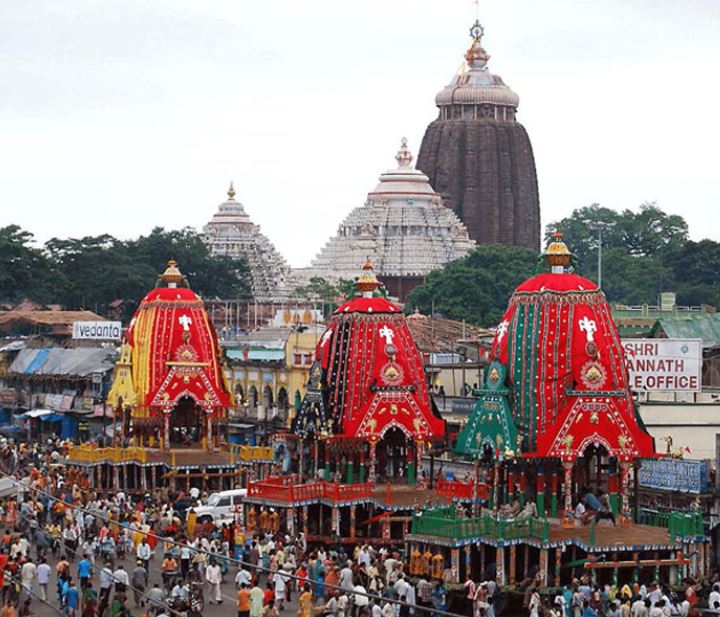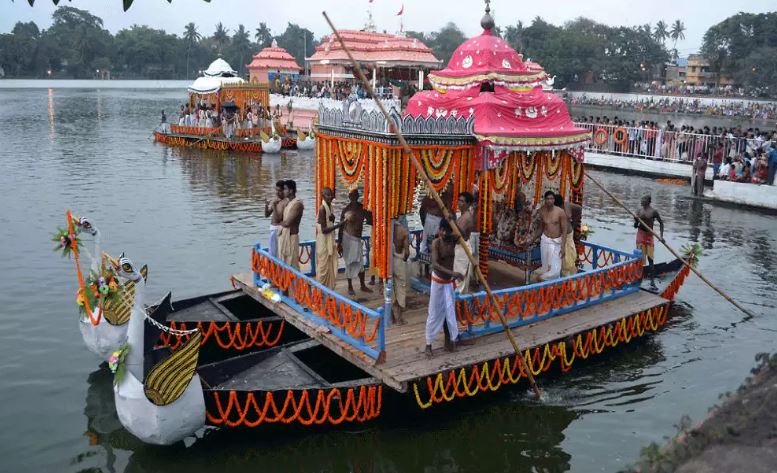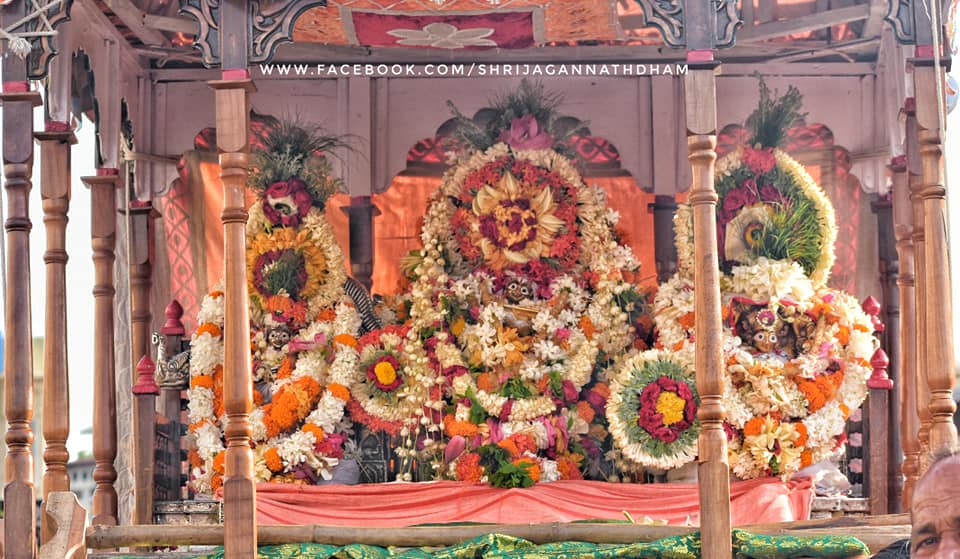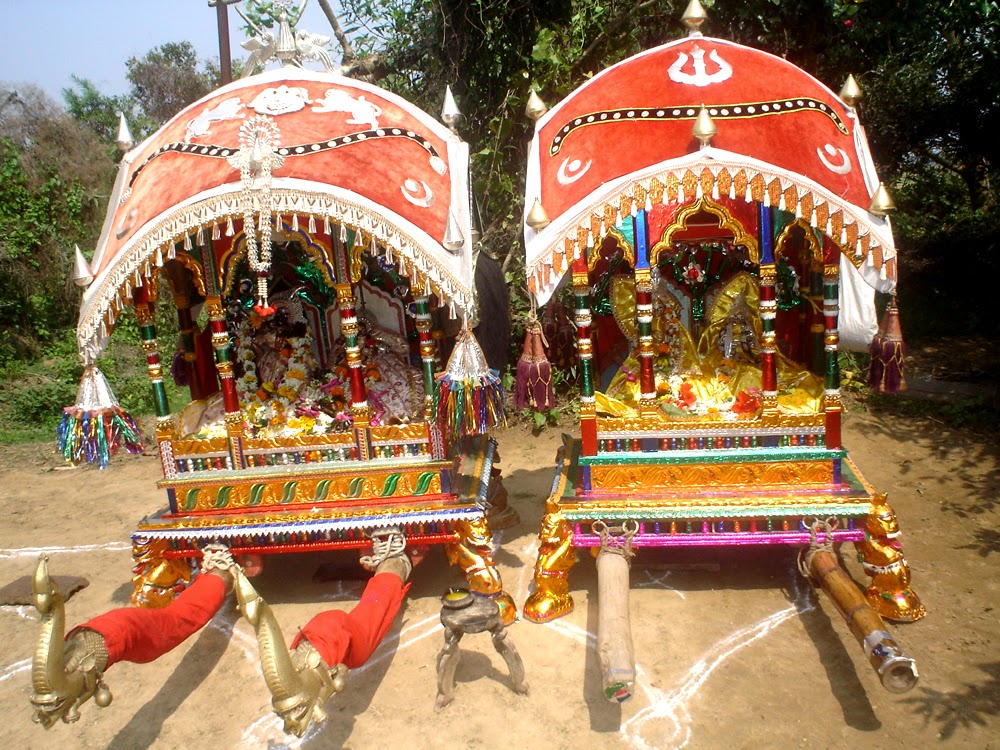Kailash Chandra Dash

Festivals in Odisha in the colonial phase were accepted not only as part of their cultural heritage, but also appreciated as an articulation to sustain Odia cultural space. Chandan yatra, Ratha yatra, Durga Puja, Dola, Jhulana and Melana were considered festive occasions of the Odias which sustained Odia cultural space as there was distinct socio-cultural traits in the mode of their observation in the colonial phase.
An important festive occasion in Odisha continued from the medieval phase to the colonial phase was the famous Chandan Yatra which usually appeared in the month of May in the Christian Calendar. The occasion had distinct contribution to the cultural mainstream of Odisha. According to an Old Odia tradition-Ali Jhulan, Olakana Melana, Kendrapara Ram Navami and puri Chandan were the most famous in India. The Chandan Yatra in Puri region was very gorgeous, although Odia newspapers of 19th century refer to its celebration in Cuttack in Binid Behari Zone in a grand manner.The Odia news weekly Utkala Dipika in this connection states that the Chandan festival was observed in different parts of Odisha, but Puri’s Chandan Yatra was the best.(Utkala Dipika, 5th June 1875) Utkala Dipika describes the uniqueness of the Yatra despite the significant ceremony of Ratha Yatra in Puri which is actually the national festival of Odisha.But Chandan Yatra was another great festival of Puri for the participation of the people in a leisurely mood not like serene devotees on the occasion of Ratha Yatra. The time of Chandan was very appropriate for enjoying the occasion. Hence the people of Puri had participated in the amusement in the Yatra. Puri consisted of many Akhara gharas in the different lanes (Sahis) which were called Jegaghara. The Jegagharas were the centres of the people in their leisurely hours and places of entertainment. Boxing training and music discussion were the chief occupations of the people in the Jegaharas. It enhanced good relation and unity among the people. Despite the degeneration of the Akharagharas due to the bad habits of the people the Akharas were very active during the Chandan.The Akharas appeared in a grand procession on the occasion of the Chandan in Puri. Every Akhara contained trained boxers and Gotipua dancers or singers. This participation of the Akhara made the Chandan spectacular and enjoyable for the people. Without Akharas in Puri Chandan would have been colourless.
This Yatra was observed in the different Brahmana sasanas in Puri. In different villages different methods were followed on this occasion. The Chandan Yatra of Biswanathpur in Puri was a unique one in the 19th century.(Ibid.,3rd July 1886) In that village Gopinath was the presiding deity.According to tradition it was originally decided to be established as Madan Mohan(Chalanti pratima) in SriMandira and for that the deity was kept in Changadaghara. Later on it was shifted to Biswanath Pur by Vajpayee Somnath Rajguru.(Ibid.) The image was made of metal. From Akshaya Tritiya every day from the western to eastern frontier of the village the deva moved in a jewelled vimana. After the end of the chapa (pressure)during the return journey in the night Akhara, dagara nritya and songs were performed. The deity in a procession entered into the temple. In the 18th day the occasion assumed a grand shape. In 1886,the festival in Biswanathpur was very enjoyable. In that occasion Nrittarathas, Roshni and Phulajha das were plentily available.Thousands of visitors attended it and about four hundred rupees were spent for the occasion. The Chandan pond of the village was very old.(Ibid.)
In the 20th century Chandan Yatra was celebrated with great pomp. Due to the effective managership of Rajkishore Das in the Puri temple in the first decade of the 20th century the Yatra had considerable success. Rajakishore Das first of all cleared (re-built) the Chandan Mandap of Narendra tank which became avery attractive centre for the occasion. The first portion in front of the mandap was covered with vermillion and chandratapa as well as with flowers and flags. It enhanced the elegance of the mandap. The two chapas(Pressure makers) were painted with different figures and adorned with clothes. The mandap was lighted in the night which added to its attraction.(Ibid.,23rd April 1904)
Cuttack was also an important centre of Chandan Yatra in the medieval phase which also continued in the colonial period. Chandan Yatra of Benod Behari was very old. According to the newspaper report, the Chandan Yatra of Ganga Mandir (Cuttack) was completed in 22 days in 1880.(Ibid., 5th June 1880) The Chandan Yatra of Buxi bazar was famous in the 19th century and it was performed by the collection of subscriptions collected from the people of the area.(Ibid.)
In the 20th century Chandan Yatra was gorgeously performed in Cuttack. It was an important festival of Cuttack. It was performed in several places of Cuttack.(Ibid., 14th May 1904) The Chandan Yatra of Kanika Royal House was the best of all in Cuttack. The Yatra was completed within the days stipulated. The Yatras in all the other sites in Cuttack were performed in the last five days of the stipulated phase. The Binod Behari Yatra also had continued in this phase. In the Chandan Yatras in Cuttack there was no great emphasis on chapakhela (pressure sports). Emphasis was on dance and drama.There were female dancers (Bais dance), dance by Natua boys and lila were also performed. Each Yatra was just like a market of dance (nrityara hata). There was decline of Chandan Yatra of Cuttack for over-emphasis on amusement. The Odia nationlists felt that the Chandan Yatra in the 20th century had lost its important link with religion and society in Odisha and so they emphasised on its reform for asserting Odia cultural identity.(Ibid.,14th May 1904)
An important point for Odia’s concern for Chandan Yatra which they thought would reflect their identity and cultural distinctiveness was furnished by Utkala Dipika in 1914.(Ibid.,23rd May 1914) It refers to the Chandan Yatra of Chaudhuri Bazar (Municipal Garden). An artificial mandap was build up inside the pond and the god was placed on it. The people at first invited a young artist named BaishnavaPani for making Yatra.His Yatra could not be appreciated by some people who invited a Yatra party from Balasore. The members of the Balasore party were Odias but they actually performed Bengali Yatra. Many people had gathered to see this Yatra. But Baishnava Pani who was not successful in Chaudhuri Bazar did his Yatra near Binod Bihari which was very appealing. Many people left Balasore party to see the Yatra of Pani. The Utkala Dipika of course emphasised the value of Bengali theatre on the occasion of Chandan in Buxi Bazar. But the activities of Baishnava Pani indicated the cultural consciousness of the Odias . The Chandan Yatra of Radha Prasad Bhagat and Ana Sahu in Buxi Bazar were unique in this period.

The Chandan Yatra was a marker of Odia’s cultural identity. Ratha Yatra of Jagannath was regarded as the most important festival in Odisha which continued from the medieval period to the colonial phase. Jagannatha was the presiding deity of Odisha and from the stage of a Hindu deity it was Odianized. Odias in the 19th and 20th centuries accepted Jagannatha as an unmistakable marker of their identity. Among the countless pilgrims visiting the Purushottama Kshetra on the occasion of the Ratha Yatra and Nabakalebara Yatra Odias in a nationalistic passion declared Bengali Jatris and Paschima Jatris as Paradesis and Odias as Swadesis- a feeling as presented in Odia periodicals of this phase which is indicative of the growing Odiaization of Jagannatha. (Dash 1998:7-13) The visitors outside Odisha considered the Yatra of Jagannath as a famous Hindu festival, but Odias considered this Yatra in the colonial period as the famous Odia festival. The Chhera Pahamra which was a part of the Ratha Yatra, although was despised by the outsiders, was accepted as a significant occasion by the Odias in the 19th and 20th century A.D.(Utkala Dipika,1904:Dash 1979)
The cultural life of the Odias was sustained by the great Puja festival of the month of October. This occasion was well- known in Bengal and in South India. The Odias had no distinctive-ness in this respect. The festival which was gorgeously observed in Cuttack, the main centre of colonial Odisha, was mainly confined to Bengali idea. Some innovations could be discovered in its celebration in the feudatory states.(Utkala Dipika,6th November 1920)The practice was for the celebration of this occasion the army appeared in the capital city, The national flag of the state was hoisted in one place. The king of the state went to that direction for war to which the national symbol(flag) swung. Hence the Dasahara festival encouraged the heroism of the Odias in the feudatory states in new enthusiasm. This practice was well-known in the pre-colonial period, but it was not known in the colonial period. On the occasion the kings with their army in the colonial phase were busy in hunting, the militia united in the capital to show the test of their strength. It was just like the annual parade of the army in the Odisha States. Hence the annual Dasahara Puja in the pre-colonial period in Odisha States strengthened national power. The Odia nationalists were disappointed to see the festival, an imitation of Bengali attitude.(Ibid.) It did not reveal the identity of the Odias. The Odias had taken the puja of the deity as the worship of Odia heroic qualities, the gathering of national energy in the pre-colonial phase. The observation taking the shape of Yatra-Suanga was a repetition of that followed in Bengal.
Odia quest for cultural identity reflected in the first two decades of the 20th century on the occasion of Dussehra. In 1917 a unique Dasahara festival was celebrated by the school students in Cuttack.(Ibid.,10th November 1917) While the image was on the way to immersion, the students prepared a portrait (Chitra Patta) of fragmented Utkala which was the idea of Madhusudan Das in which Mother Utkala was in one direction and her banised daughter in another direction. In the gap there was sea. It means the sea of political administration (Colonial Power) has kept the daughter separated from her mother. Both mother and daughter were looking to one another, but the daughter is banished. She has no way to return to her motherland. The young group kept the portrait before the image of Durga and shouted with the slogan “ Jay Utkala Jay” which was widespread. The Odia nationalists in this phase in their quest for a complete Odisha viewed the terrible image of Durga (Chhinnamasta) in the deformed and scattered image of Utkala Mata. They believed that in near future the fragmented body of Mother Utkala would take a full shape in the form of the cheerful Bhuvaneswari image which was worshipped on the occasion of Durga Puja. (Asha, 2nd October 1916)

Jhulan Purnima was another celebrated occasion in Odisha in the colonial phase which represented Odia space. The Jhulan festival was very famous in Aul in Odisha. The Jhulan Bada or Jhulan Mandap was gorgeously decorated on the occasion. It was also observed in the Maths of Cuttack. The occasion was remarkable for musical performance. Both dance and song were appreciated by the larger public. The Mathdharis invited the landlords and royal officers to see the occasion.(Utkala Dipika, 21st August 1875) The Benod Behari Jhulan festival was very famous in Cuttack in the 19th century.(Ibid., 5th January 1878)The original intent of the occasion is to place the presiding deity in a vimana in one side of the temple and to swing him in a slow manner. It aimed to foster devotion in the minds of the devotees. The Jhulan Yatra, besides its religious import, became colourful by music. People came to the temples in the night and enjoyed Gotipua dance.(Ibid., 23rd August 1884)
On the Jhulan occasion Benod Behari area became the testing ground for the higher sections having predilection for music. The musical activities on the Jhulan was a time honoured practice, but there was no improvement in the songs and dances which were actually in advance in Bengal. The Odias in their eager quest for an identity in India in the colonial phase wanted reform in the field of music and they wanted to place it at par with that of the Bengalis. This consciousness appeared when they saw the decline of musical activities in Jhulan in the 19th century.
The Jhulan of Ali was very popular in the 19th and 20th century A.D.(Ibid.,10th September 1904) In Ali there is the seat of Gopal Jeo whose Jhulan mandap was the most important for this occasion. There were three bands of female dancers and other natuas who performed dance and song had enjoyed jagir of the royal house. The occasion also witnessed the Gahma-abhiseka of the Ali king. According to the long standing practice,on the Gamha-Purnima day there was the abhiseka (consecration) of the state deity, Baraha Jeo and on the third day the coronation of the chief was performed . The distance between royal palace and the temple of Baraha Jeo was about one mile and there was a long road between the two. On the purnima day at about 12 A.M.the king in his tamjan accompanied by his chief officers on horses and elephants with materials of puja, purohita and other Chhatisa Jog and dancers in a grand procession came to Baraha Jeo. Thereafter Bhog and alati having been completed the deity’s consecration was done. Outside the temple, female dancers performed dance and the crowd was full in the fort to observe the grand occasion. After two hours all returned to the royal residence and the chief was consecrated when the Brahmins and later on the sardars of his jagirs placed rasi in his hand.Then the chief distributed pan to all his officers. On the third day the chief after visiting Baraha Jeo in a procession sat on the throne. The royal area was filled with dance(both by male and female dancers) and the sound of various musical instruments. Thus Ali festival has its own specialities. It is a significant part of Odia cultural space in the colonial phase. Jhulan Mandapas were found in many of the feudatory states of Odisha which could articulate a common cultural identity. In Puri Jagannath’s Jhulan day was also entertaining. The Jhulan Bada was well decorated. In 1907 separate Jhulan Khanjar were there near Mukti Mandap and the Jhulan Kunja was very attractive with colourful objects. The images of Narayana and Harihara were also very attractive. The centre of amusement became elegant in the light balls in wood and glass pots. Every day the akhara boys of the Sahis had their cultural activities. The Jhulan of the temple was more beautiful than that of the Maths and other places in Puri in 1907. (Ibid., 24th August 1907)The Jhulan of Puri temple in 1913 was the most attractive in puri. The Sri Mandira Kunja was lighted with different light balls. The Jhulan at Ganga Mata Math and of Madhi Mahapatra had their special value. Various theatrical parties from different parts of Odisha came to Sri Mandira for cultural shows.(Ibid., 23rd August 1913) In 1913 the Jhulan Yatra of Cuttack was also gorgeous. The Mahant of Gopal Jeo Math was very effective on this occasion, The Jhulan bada was well furnished like that of Binod Behari. In 1913 a Natua boy of Nuagarh had a very important role in the work of entertainment. He could sing clearly and correctly Bengali, Odia and Hindi songs. Such a singer was then considered a rare one in Odisha.(Ibid.)
The Jhulan Purnima provided an important cultural space in Odisha which in the colonial phase despite a decline in musical activities articulated Odia’s longing for their old cultural practices. It indicated a continuity of Odia cultural life from the pre-colonial to the colonial phase.

Dola Yatra and Malan constituted significant cultural space for the Odias from the medieval period up to the colonial phase. The Dola Yatra comes first and then comes Melan. The Yatra was well observed in the villages of Odisha. Dolyatra of Kendrapara was unique in the 19th century Odisha for accompanying musical activities. Dancing was an important part of the Dola festival of Kendrapara.(Ibid., 11th March 1882) Melan is an occasion for the congregation of gods in the central place in different village sasanas (Stietencron 2001:363-401) Melan provides an important link between the villagers and is perhaps only known in Odisha. In no part of India except Odisha this is celebrated.(Asha, 27th March 1916) It articulated Odia identity. Odias had a tendency for collective life and collective amusement. In the melan not only the people congregated but also their gods and this resulted in a cultural intercourse. Many necessary articles were brought to the Melan for business and the village people got an opportunity to possess valuable articles for their use only in Melan. Just as in the holidays like X Mas and Good Friday the educated people in India go to attend Congresses and Conferences the Odia villagers take this leisure phase in spending happy time in Melan.(Ibid., 30th March 1914)
The melan at Balanga near Pipli (puri District) was well known in the 19th and 20th century Odisha. (Utkala Dipika, 23rd March 1912)The Melan at Chhatia was very attractive in the 20th century due to the effort of Bholanath Nanda, Mahajana of Chhatia and the Chaudhuri family of Bheda.(Ibid., 13th March 1920) The melan of Gopinath Jeo (Balia) was also famous in the colonial phase. There were six melan sites in Balia, but the Narsimhapur Balia Melan was a unique one.(Ibid., 13th March 1920)
In the 20th century with the spread of nationalist activities in Odisha, Gopabandhu and his associates were very keen to use these occasions and the rural centres like Bhagabata Ghara and Akharas for animating the Odias with the idea of nationalism. They even wanted to convert the Bhagabat Mandir and Jegagharas as Gramyasamitis for spreading the message of Utkala Sammilani which would mobilize the rural areas for asserting their identity in colonial phase. (Asha,30th March 1914) They also wanted to convert the Melas as Chakla or Kendra Samiti of the Utkala Sammilani just like the role of the Hindu Melas of Bengal in reforming Hindu Bengal Society, (Choudhury 1998:11-39)
In an editorial note in Asha Gopabandhu Das, a great Odia nationalist had concluded that for the construction of national identity, all old elements should be utilised with good result. (Asha, 30th March 1914) He had emphasised that the Odias had to work in villages in order to construct this identity. This view was repeated in 1916 in another note in Asha.(Ibid., 27th March 1916) Thus cultural centres and festival occasions in Odisha in the 19th and 20th century reflected the Odia concern for asserting identity by way of reforming them or elaborating them.





















